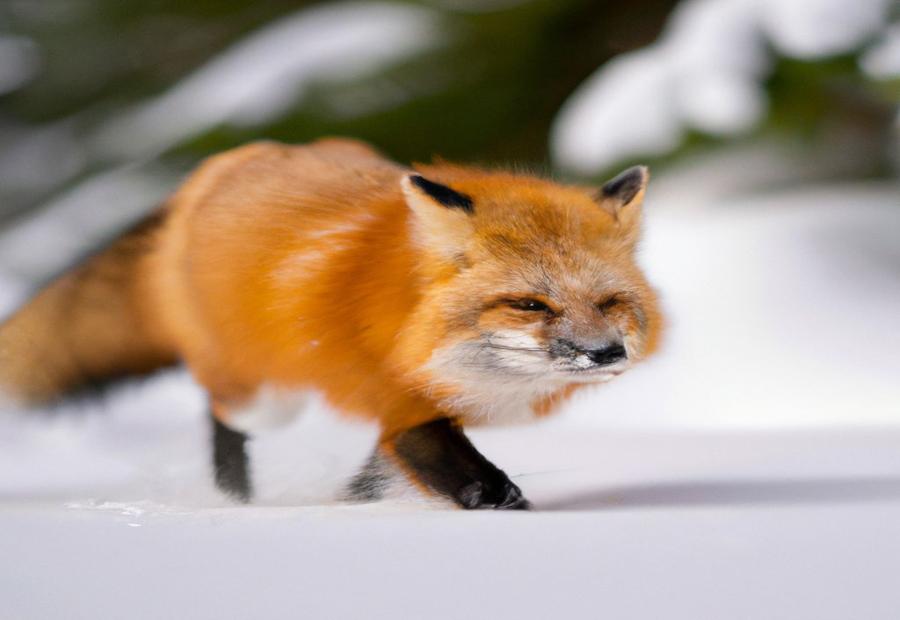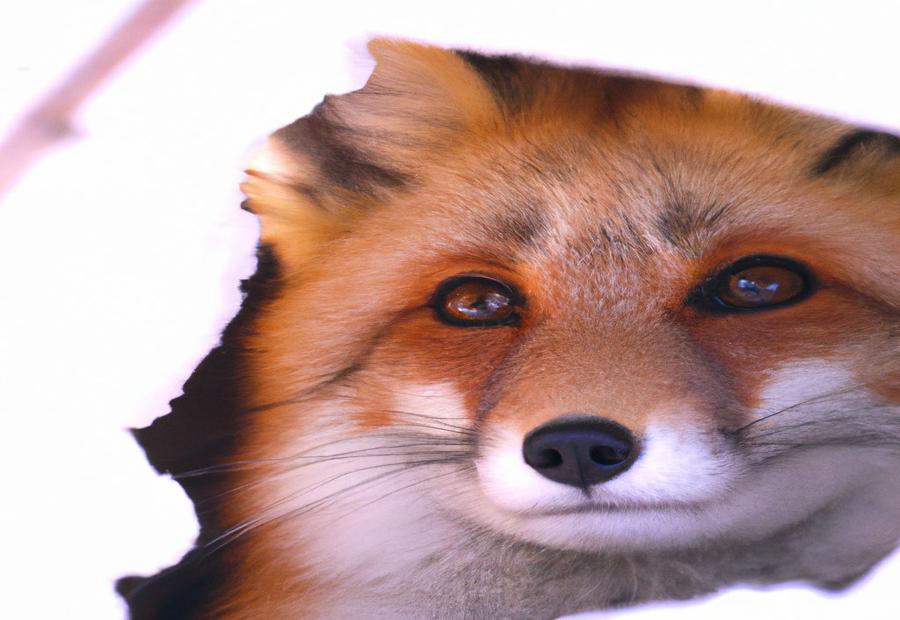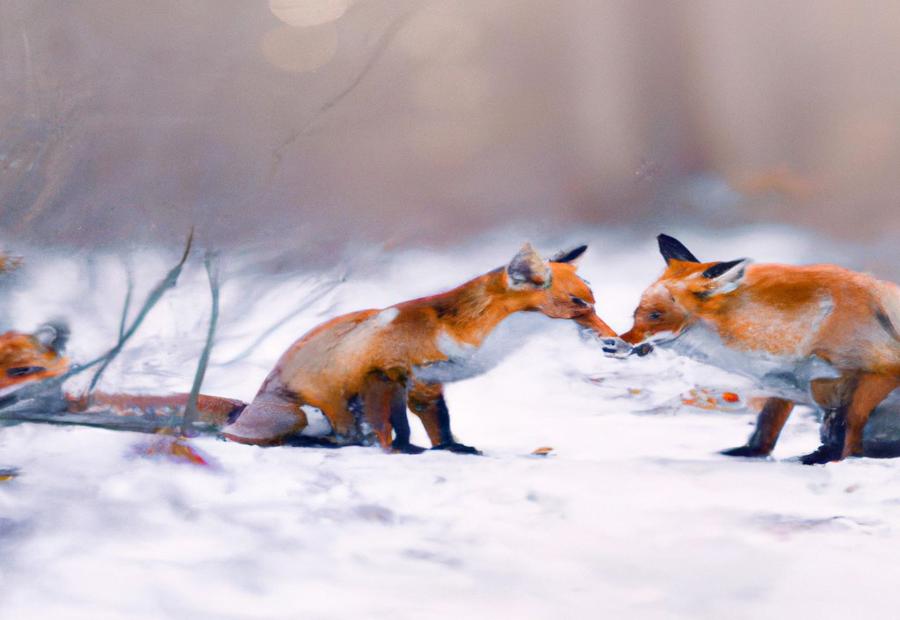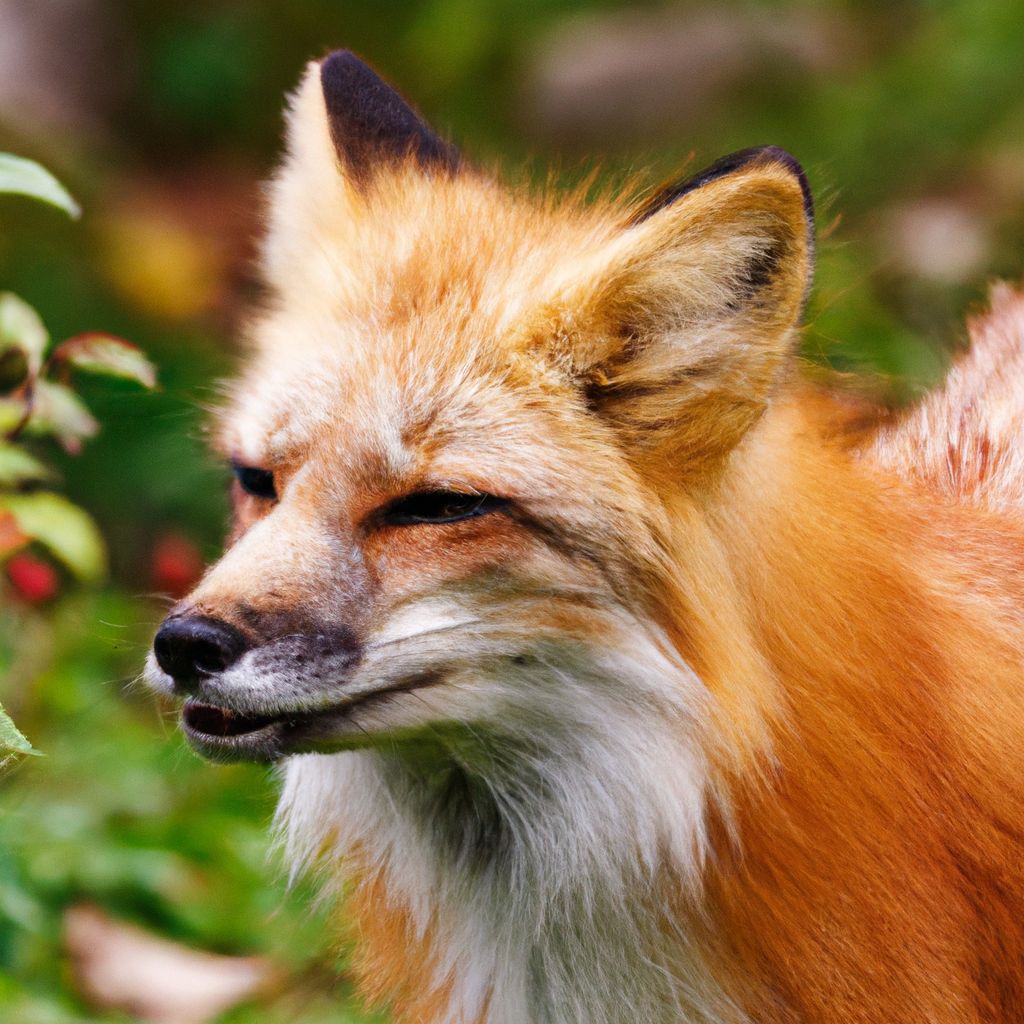Vulpes Vulpes, commonly known as the red fox, is a fascinating species known for its adaptability and survival skills in various environments. In the winter season, when temperatures drop and resources become scarce, this species exhibits remarkable adaptations and behaviors to thrive. Understanding the winter behavior of Vulpes Vulpes can provide valuable insights into its ecological resilience and survival strategies.
The red fox adapts to winter conditions in multiple ways. One adaptation is in its fur and insulation. This species has a dense and thick coat that provides excellent insulation, keeping the fox warm even in extremely cold temperatures. The red fox will grow a thicker winter coat during this season, ensuring better protection against the cold.
Behaviorally, the red fox has specific changes in its daily routine during winter. It tends to become more nocturnal, maximizing activity during the night to conserve energy and reduce exposure to harsh winter conditions. By being more active at night, the red fox can take advantage of decreased competition for resources.
When it comes to hunting and foraging, the red fox employs specialized strategies in winter. Prey selection becomes crucial, and the red fox focuses on smaller animals that are more abundant during this season. It has adapted its hunting techniques to navigate snowy environments, utilizing pouncing and leaping techniques to catch its prey in the snow. The red fox employs tracking techniques, relying on its acute senses to locate food sources even in challenging winter conditions.
During winter, the red fox also seeks suitable dens and shelters to protect itself from the harsh elements. They utilize existing burrows or dig their own dens in snow banks or under fallen trees. These dens serve as a safe haven from extreme temperatures, wind, and predators. The red fox may also create multiple dens within its home range, allowing for flexibility and survival options.
In terms of reproduction and social structure, the winter season impacts the red fox’s behavior. Breeding typically occurs in winter, with a gestation period of about 51-53 days. Red foxes form monogamous pairs during this season, and both parents participate in raising the offspring, denning together to provide warmth and protection.
Contents
- 1 Adaptations of Vulpes Vulpes to Winter
- 2 Hunting and Foraging Strategies of Vulpes Vulpes in Winter
- 3 Winter Dens and Sheltering Habits of Vulpes Vulpes
- 4 Reproduction and Social Structure of Vulpes Vulpes in Winter
- 5 Frequently Asked Questions
- 5.1 1. How do red foxes survive winter’s harsh temperature and snowy landscapes?
- 5.2 2. What do red foxes eat during winter?
- 5.3 3. Do red foxes hibernate during winter?
- 5.4 4. How do red foxes stay warm in winter?
- 5.5 5. What are some field skills for observing red foxes during winter?
- 5.6 6. Can red foxes be found in urban areas during winter?
Adaptations of Vulpes Vulpes to Winter
Did you know that the cunning Vulpes Vulpes, also known as the red fox, possesses remarkable adaptations to survive the harsh winter? In this section, we’ll explore how these crafty creatures utilize their fur and insulation to stay warm and cozy in the cold months. Additionally, we’ll uncover the fascinating behavioral changes that red foxes undergo during winter, allowing them to thrive in snowy landscapes. Get ready to dive into the chilling world of Vulpes Vulpes!
Fur and Insulation
Fur and insulation are essential adaptations of Vulpes Vulpes to winter. The table below presents information about the fur and its insulation properties:
| Fur Type | Insulation Properties |
|---|---|
| Dense Undercoat | Traps air close to the body, creating a barrier against cold temperatures. |
| Guard Hairs | Protects the undercoat and provides additional insulation. |
| Color Variation | The fur color can vary depending on the geographic location of the fox. In colder regions, the fur is usually lighter in color, helping camouflage the fox in the snowy environment. |
| Fur Thickness | Becomes thicker in winter, providing enhanced insulation and protection from the cold. |
The fur of Vulpes Vulpes is a vital factor in helping the fox survive harsh winter conditions. The undercoat and guard hairs retain body heat, while the varying fur colors aid in blending with the surroundings and avoiding detection. Additionally, the thicker winter fur provides added insulation, keeping the fox warm in low temperatures.
The fur and insulation of Vulpes Vulpes play a crucial role in its winter survival, enabling the fox to withstand the cold and continue activities like foraging and hunting. It is an impressive example of nature’s adaptation and the fox’s ability to thrive in diverse environments.
Behavioral Changes
Behavioral changes in Vulpes Vulpes during winter are crucial for their survival. These adaptations play a key role in conserving energy and facilitating efficient food finding.
One behavioral change is the increased nocturnal activity of Vulpes Vulpes during winter. They become more active at night, taking advantage of cooler temperatures and avoiding potential predators.
To conserve energy, Vulpes Vulpes also adopts longer resting periods during the day. They spend more time resting in dens or sheltered areas, minimizing their exposure to the cold.
Another important behavioral change is the hoarding of food. In preparation for winter food scarcity, Vulpes Vulpes strategically stores food by digging burrows and hiding extra food such as small mammals or carcasses. This ensures a reliable food source during lean times.
Vulpes Vulpes also improves its hunting techniques in winter. They adapt their strategies by relying on stalking and ambush techniques to catch slower prey like rabbits or rodents in snowy environments.
During the winter season, Vulpes Vulpes may exhibit increased social behavior, often grouping together in larger numbers. This enhanced interaction provides warmth and protection against the cold.
Remember, when encountering a Vulpes Vulpes during winter, it is important to observe from a distance and avoid disturbing their natural behavior. Respecting their space allows them to effectively conserve energy and adapt to their environment.
Hunting and Foraging Strategies of Vulpes Vulpes in Winter

Photo Credits: Foxauthority.Com by Joseph Ramirez
In the depths of winter, the cunning Vulpes Vulpes employs ingenious strategies to thrive in its snowy habitat. Discover the secrets of their hunting prowess and foraging techniques as we delve into the world of these resourceful creatures. From the art of prey selection to their masterful tracking techniques, we’ll unveil the survival tactics that make the Vulpes Vulpes one of nature’s most adept winter hunters.
Prey Selection
Vulpes Vulpes exhibits a diverse diet, with its prey selection in winter being dependent on both availability and hunting capabilities. It commonly targets small mammals, such as voles and mice, which are abundant and provide a convenient food source. In areas where larger prey species like rabbits and hares are present, Vulpes Vulpes may also include them in its diet, as these larger prey items can sustain the foxes for longer periods. Additionally, birds, both ground-dwelling and airborne, are part of Vulpes Vulpes’ prey selection. The foxes utilize their agility and speed to capture these avian species, contributing to their dietary variety. In some instances, Vulpes Vulpes may scavenge carcasses that have been left by other predators, thus conserving energy and reducing their hunting efforts. It is important to note that the availability of prey species can vary greatly depending on both location and environmental conditions. Vulpes Vulpes is known for its adaptability and may adjust its prey selection accordingly. Particularly during the winter when resources are scarce, Vulpes Vulpes prioritizes smaller prey items that require less energy and effort to capture. The selection of prey is greatly influenced by Vulpes Vulpes’ hunting proficiency and skills. The foxes heavily rely on their keen senses, agility, and stealth in order to successfully capture their preferred prey. The ability of Vulpes Vulpes to select appropriate prey plays a significant role in its survival and overall reproductive success during the winter season. Furthermore, its ecological role in prey selection is crucial in regulating populations of various species, thus contributing to the overall balance of ecosystems.
Tracking Techniques
When it comes to tracking techniques, the red fox employs several strategies to locate and pursue its prey.
One important technique is maintaining a trail. The red fox leaves scent markers, such as urine and feces, to create a trail that it can follow or return to later. These scent markers help the fox navigate its surroundings and communicate information to other foxes.
Another tracking technique used by the red fox is scent marking. By urinating on objects like trees or rocks, the fox marks its territory and alerts other foxes to its presence. This helps establish boundaries and prevent conflicts.
Observation and recognition also play a vital role in the red fox’s tracking abilities. They carefully observe their surroundings, looking for signs of movement or potential prey. With their keen senses, including excellent hearing and vision, they quickly recognize their target and adjust their hunting strategy.
True story: One winter, a photographer stumbled upon fresh fox tracks in a snow-covered forest. He followed the tracks and spotted a red fox in the distance. The fox seemed unaware of his presence, engrossed in its search for food. The photographer observed the fox’s tracking techniques and captured a stunning photograph, showcasing the fox’s tracking skills in its winter habitat.
Winter Dens and Sheltering Habits of Vulpes Vulpes

Photo Credits: Foxauthority.Com by Vincent Garcia
During the winter months, Vulpes Vulpes, commonly known as red foxes, exhibit specific habits for finding shelter and protection from predators. These intelligent creatures either utilize existing burrows or construct their own underground dens with multiple entrances, facilitating quick escapes when needed. To ensure insulation, the red foxes line their dens with various materials such as leaves, twigs, grass, and fur.
Additionally, within their territory, they may have several dens to provide different sheltering options based on weather conditions and disturbances caused by other animals. Notably, during heavy snowfall, these resourceful animals even resort to using snow dens, which provide excellent insulation and protection. Impressively, female red foxes establish separate maternity dens to ensure a safe and warm environment for raising their young until they are ready to explore the outside world.
It is of utmost importance to respect these fox dens and observe them from a distance, as close proximity may cause stress and abandonment. By studying the winter dens and sheltering habits of Vulpes Vulpes, we gain a deeper appreciation for their exceptional adaptations to survive the harshest conditions. Therefore, it is crucial to honor their space and refrain from interfering during their vulnerable winter months.
Reproduction and Social Structure of Vulpes Vulpes in Winter

Photo Credits: Foxauthority.Com by Thomas Moore
Reproduction and Social Structure of Vulpes Vulpes in Winter
The reproduction and social structure of the red fox, known as Vulpes Vulpes, change in winter due to factors like food availability, environmental conditions, and social dynamics within the fox population.
1. Mating Season: Red foxes mate during winter. Males mark territory and make sounds to attract females. Breeding pairs stay together throughout the season.
2. Gestation and Birth: Female red foxes have a gestation period of around 51 to 53 days. Most births occur between February and March. Females create dens for giving birth, providing a safe and warm space for their offspring.
3. Social Structure: Red foxes have a hierarchical social structure. Dominant individuals have priority access to resources. In winter, there is more competition for food due to limited availability. Dominant males and females have better chances of surviving and reproducing.
4. Parental Care: Both male and female red foxes help raise their young. Males assist in providing food. Kits start leaving the den in late winter, learning hunting and survival skills from their parents.
Suggestions for observing red foxes in winter:
1. Conduct field observations during early mornings or evenings when foxes are most active.
2. Use camouflage or blinds to observe foxes without disturbing them and to see their natural behavior.
3. Focus on areas with abundant food sources, like open fields or areas with small mammal populations.
4. Document social interactions, such as dominance displays or mating behaviors, to gain insights into their behavior during winter.
Understanding the reproduction and social structure of Vulpes Vulpes in winter provides valuable insights into their survival strategies and adaptations to the challenging conditions they face during this time of year.
Frequently Asked Questions
1. How do red foxes survive winter’s harsh temperature and snowy landscapes?
Red foxes have evolved with strategies and physiological adaptations to cope with winter conditions. Their fur coats grow thick and long, up to their footpads, which helps with heat insulation. They also have relatively small body parts, including their legs, ears, and neck, which reduces the amount of body surface exposed to frigid temperatures and helps conserve body heat. Additionally, their tails are extra thick and can be wrapped around their bodies for extra warmth.
2. What do red foxes eat during winter?
The red fox’s diet varies according to seasonal abundance. In the summer, they supplement their diet with berries, apples, pears, cherries, grapes, grasses, and acorns. Throughout the year, they feed on grubs, insects, and small mammals such as rabbits, rodents, and squirrels. They rely on their sharp hearing, which allows them to detect mice even under the cover of snow.
3. Do red foxes hibernate during winter?
No, red foxes do not hibernate during winter. Although they are less active compared to the summer months, they still venture out early in the morning to hunt for their next meal. They continue to be active throughout the winter season, adapting their behavior and food sources to fit their environment.
4. How do red foxes stay warm in winter?
Red foxes stay warm in winter through various adaptations. Their thick and long fur coats provide insulation from the cold. They also have relatively small body parts, which help conserve body heat by reducing the amount of body surface exposed to frigid temperatures. Additionally, they can wrap their extra thick tails around their bodies for extra warmth.
5. What are some field skills for observing red foxes during winter?
Observing red foxes during winter requires patience and keen observation skills. Some field skills for observing them include slowing down and being alert, looking for subtle movements or out-of-place signs. Tracking their distinctive tracks, which resemble a dainty dog, can also make it easier to follow them. Additionally, being aware of the musky scent they leave behind as territorial markers can occasionally help with detection.
6. Can red foxes be found in urban areas during winter?
Yes, red foxes are highly adaptable to human-made habitats and can be found in urban areas during winter. In fact, they can be found in 90% of urban habitats in the United Kingdom. They alter their habits and food sources to fit their environment, making them capable of surviving and thriving in urban settings.


